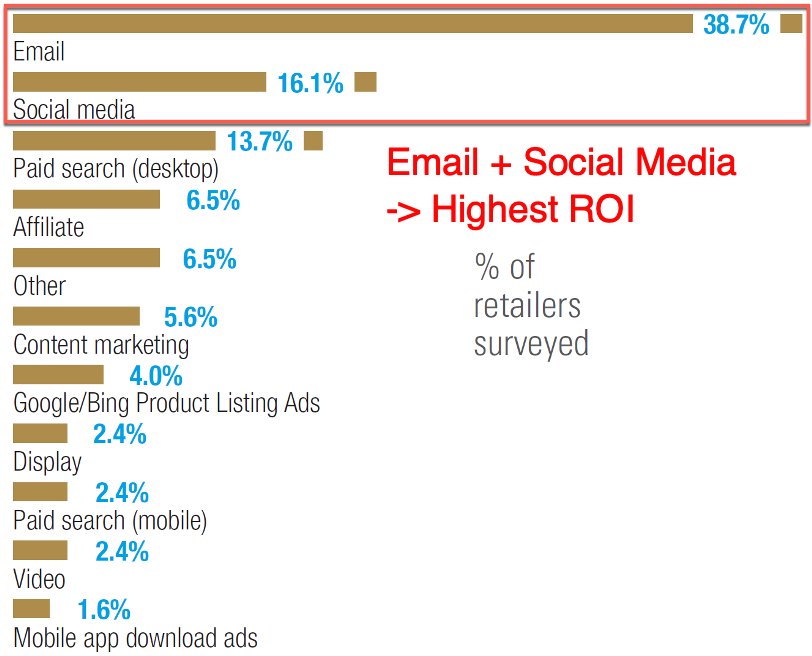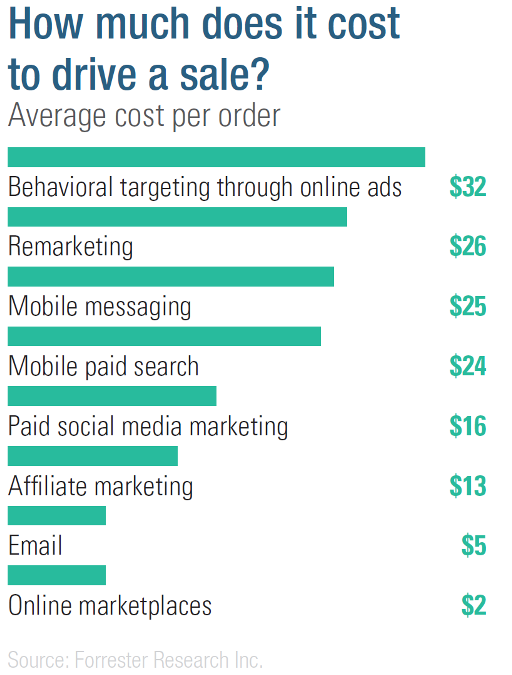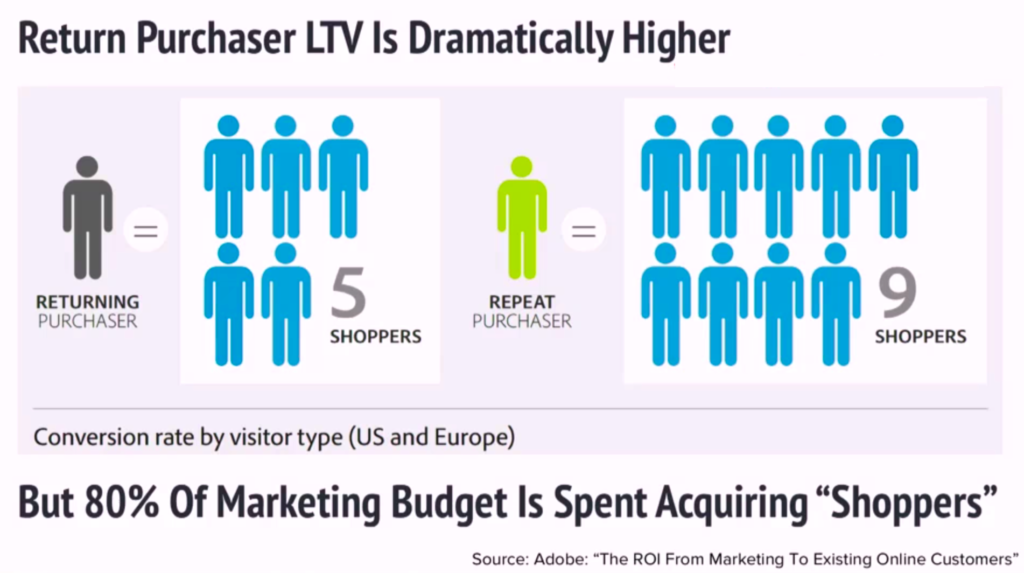30 Ecommerce Experts Reveal 3 Favorite Strategies To Build a DTC Brand
Building and growing an eCommerce direct-to-consumer brand is challenging. There are so many tools, tactics, and strategies which could easily overwhelm you.
I asked 30 eCommerce experts and prolific bloggers a simple question:
“If you could use 3 tactics/strategies to drive revenue for DTC (direct-to-consumer) brand, what would they be?”
I wanted to know plain and simple which strategies I must seriously consider and what I can live without.
Read on to discover each expert’s favorite 3 strategies along with their awesome tips on how to use them! You can either skip to your favorite expert using these quick links or grab a coffee, get comfortable and start scrolling!
Michael Nguyen, Kurt Elster, Adam Pearce, Fred McKinnon, Alex Fedotoff, Jeff Cleasby, Dan Kern, Gavin Duff, Alisa Meredith, Jennifer Glass, Rachel Andrea Go, Nathan Hirsch, Eric Bandholz, Jeff Oxford, Chase Diamond, Chloe Thomas, Arun Kothapally, Melissa Tanzosh, Chris Brewer, Greg Shuey, Matt Janaway, Lianna Patch, Matthew Sabia, Jay Myers, Stephanie Hooper, Raphael Paulin-Daigle, Steve Chou, Charles Palleschi, Brendan Tully, Chase Clymer, Kevin Zhang
Responses listed in the order they were received in:
Michael Nguyen
Ecommerce Rainmaker
Michael Nguyen helps eCommerce owners grow, scale, and exit their business.
1. Focus on Email Marketing + Social
According to the Internet Retailer Best Ecommerce Marketers 2017, email marketing & social are the top 2 channels providing the highest ROI compared to others.

Besides having the highest ROI, Email + Social Media are having the lowest cost to drive a sale.

The key is to have the discipline to work on email marketing and social media on a consistent basis.
2. Segmentation using “RFM Method”
According to Adobe, returning customers worth 5x than one-time shoppers and repeat customers worth 9x than one-time shoppers.

That’s why focusing on turning one-time shoppers into returning or repeat shoppers is a great lever to increase your revenue.
And the “RFM Method” is a perfect tool to achieve this objective.
RFM stands for Recency – Frequency – Money to determine which customers you need to pay MORE attention to others.
The common mistake I saw 99% of shop owners do wrong with email marketing is that they treat every single THE SAME.
In reality, each customer is not created equally and that’s why returning and repeat customers are far more valuable than others.
For example, when you set your RFM of Recency = 90 days, Frequency = 3 times, Money = $200, it means you will pay more attention and communicate to them more often for customers who spent at least $200 with you, bought 3 times in the last 90 days.
The beauty of RFM is that it helps you cut down the waste when you disproportionately invest more marketing dollars to the most valuable customer segment.
3. Website & Traffic Acquisitions
This is the next level of business growth because big companies are buying out smaller companies all the time to bolster their existing offers and increase synergy. For example, 99% of eCommerce owners advertise on Facebook & Google, but as the traffic cost increases every year, you are continuously paying for traffic to increase sales.
You can’t stop this momentum because the moment you stop paying for traffic to Google & Facebook, sales stop growing.
Traffic acquisitions will help you acquire traffic sources beyond Facebook & Google such as blogs, associations, Facebook groups, Instagram accounts, etc for a fraction of the cost.
Once you buy those traffic sources, they are yours and you don’t have to pay for traffic.
The best part is that you can get your investment back in a very short time because besides promoting your offers on your owned traffic sources, you can also promote other non-competing offers to generate revenues and recoup your investment.
Now you have owned your own traffic geyser.
About Michael:
Michael is the owner of Produce Results Agency (produceresults.com) helpings its clients generate over $500 million in revenue.
Kurt Elster
Ecommerce Consultant
Kurt Elster helps Shopify store owners discover hidden profits in their websites
Three revenue levers I’d pull:
- Run a tiered free gift with purchase promotion. This lets you run a sale without discounting your brand (and thereby devaluing it) while also increasing average order value and repeat purchases. Chubbies does a great job of this. Their drawer cart includes promotions like “Spend $25, get this free can opener, Spend $50, get a free hat,” etc.
- Uncover objections to increase conversions: Use an exit-intent pop-up (like the free one from Hotjar) to ask customers exiting on desktop, “If you didn’t make a purchase today, what stopped you?”
- Tell your story: Use a framework like BrandStory or Hero’s Journey to share the story of your brand with your customers. Put it on your homepage, about page, make a video, and include it in a Welcome Series.
About Kurt:
One of the most highly regarded independent consultants in his industry, Kurt Elster is a Senior Ecommerce Consultant who helps Shopify merchants (like Jay Leno’s Garage) uncover hidden profits in their websites at his ecommerce agency Ethercycle. With one million downloads, Kurt is best known for hosting The Unofficial Shopify Podcast. You can learn more and subscribe to Kurt’s free newsletter at https://kurtelster.com/
At https://kurtelster.com/press/ you’ll find loads more cut & paste resources I put together for conference organizers, media professionals, and other interested parties. Please feel free to use it. If you have additional questions, just ask.
Adam Pearce
Ecommerce Expert
Adam frequently presents at national and international conferences on Shopify and Digital Marketing.
- Email marketing
Once a DTC brand has acquired a customer, it is critical to retain them. For our DTC clients, we typically see that email generates between 10-25% of revenue from email, when using Klaviyo. While email campaigns are important, for a DTC brand, automated flows are key. Specifically, we find that a ‘Post Purchase’ or ‘Thank you’ flow can generate significant revenue and engagement for a DTC brand. This is even more effective when using integrated review platforms and loyalty schemes like Reviews.io and LoyaltyLion.
2. Conversational marketing
Consumers shop with DTC brands because they love how ‘close’ they can get to the business. By using SMS marketing or chat on customer service platforms, DTC brands can have real conversations that lead to conversions. We’ve seen this strategy work very effectively for brands that use SMSBump to provide a facility for chat – particularly in the jewelry industry. Equally, using Gorgias to develop a structured and conversational approach to customer support is proving to be very valuable.
3. Tiered loyalty programs
While loyalty programs have been around for a while, the value of creating a ‘tiered’ loyalty program for a DTC brand is unrivaled. Using LoyaltyLion, we’ve helped many DTC brands create a tiered program that drives customers to spend more and more frequently.
Source: https://blendcommerce.com/
Fred McKinnon
Ecommerce Expert
Fred started his small e-commerce store with a niche market in the bonus room over his garage and grew it to a multi-million dollar brand. His experience on all major marketplaces has brought invaluable experience through countless victories and defeats.
- Amazon – Sponsored Product Ads
- Utilize brand ambassadors for user-generated reviews and content
- High-value contests and giveaways
Source: http://www.e-businessonline.com/
Alex Fedotoff
Founder of AF Media Agency
If you want the most effective field-tested strategies delivered in an easy-to-understand manner to influence, impact, and educate your audience Alex might help you.
- Utilize the launch strategy to boost new product sales (could be Kickstarter or just internal launch sequence to email list/ SMS/ push notification lists)
- Add multichannel strategy: Google/ FB/ Pinterest/ Bing /Display to make sure you recover as many sales and get as many customers as possible.
- Partner up with other brands that offer similar/relevant products and cross-sell each other products to the audiences of each other (as long as not directly competitive)
Source: https://www.alexfedotoff.com/
Jeff Cleasby
VP Strategic Accounts
Jeff have always been intrigued by predictive modeling and intent data as it relates to lead generation since being first introduced to semantic search in 201 plus, having worked intimately with several thousand B2B lead generation campaigns over the past four years I have noticed a strong uptick and pattern in marketing teams becoming more strategic in the leads they consume.
My opinion for 3 really solid channels tactics/strategies:
- Social – TikTok/ Facebook/ Instagram/ YouTube, etc. (anything video, and anything using humor, link these 2 together i.e. funny video)
- Digital – Think of the target audience you hope to hit and then seek out to promote on sites your target audiences are known to be at i.e. like si.com or wired.com that could build a package with print ads in their subscription magazines
- Print coupled with QR Codes – (These things have made a nice surge and comeback as of late) Use these QR codes in the print magazines from point 2 above and/or work with Val*Pak, PostcardMania, or MoneyMailer types of suppliers to put a QR code in place (on Print Ads) that are direct mailed to your target audience to drive digital engagements via their physical mailbox. With QR Codes use freebies, contests or giveaways to up the engagement
Source: https://infusemedia.com/
Dan Kern
Founder & Principal Consultant
Dan considers himself more of a strategic marketer.
- Catalog Content Search Optimization
It’s critical to keyword-research all category pages, and then optimize all category pages and product pages to ensure that the optimal keywords for each page are properly and naturally targeted via the metadata, H1 titles, and body content. Ideally the URL structure as well. For product pages, the keyword is typically the product name. However, you can append keywords to the end of the product name in the meta title, and use them in the body content to deepen organic search reach.
2. Keyword-Backed Content Marketing
Support your catalog content by targeting early buying cycle users who are investigating solutions to problems, ones that relate to the products you sell. Produce very helpful (and detailed) content about those topics, and recommend your products where it naturally fits. It’s important to focus on being educational and informational here…not “salesy”.
3. Provide a USP for why someone should buy direct through you, versus one of your vendors.
If your products are sold on Amazon as well, why wouldn’t they just take advantage of Amazon Prime for free/fast shipping? What makes buying from you, directly, better for their bottom line? You don’t have to compete on prices. Consider adding value with things like extended warranty, free accessories, etc. You may also want to consider a loyalty program if your products are the type that people would rebuy (or buy various) over time.
Source: https://www.kernmedia.com
Gavin Duff
Head of Digital Performance
Gavin is a known conference speaker, lecturer for Trinity College Dublin, podcast guest, media source, guest blogger, and many other things in the area of digital marketing.
- Use a well-segmented email list to target potential customers in your funnel. They’ve already engaged with your brand but they didn’t purchase, it’s your job to remind them. Do the same with those who have already purchased from you – they may be interested in more than what they’ve already bought. But remember that you do need to give them value and reason to return.
- SEO is not optional in the e-commerce world. Combine it with a 12-24 month content calendar for maximum planning effectiveness.
- Most marketers or brands who say that paid social media is not a direct response channel are either doing it wrong or not tracking attribution correctly. It DOES convert. You need to be very targeted and be constantly testing, otherwise, it’s just an awareness play.
Source: https://www.friday.ie/
Alisa Meredith
Pinterest Product Specialist
Alisa has written the book on Pinterest Promoted Pins (Pinterest advertising) and has conducted training for Social Media Examiner and the Agents of Change.
- Be discovered on Pinterest. Really! 97% of searches are unbranded, so you don’t need any name recognition to be found. And 77% of Pinners have discovered a new brand or product on Pinterest. There is huge untapped potential on Pinterest, you just have to know what people want and how to get them to find you. People want inspiration and information. SHOW them how you make their lives better. They’ll find you when your content is beautiful, eye-catching, and SEO optimized. Use your keywords, keep things consistent from Pin to Board to your website.
- Build on Instagram. If Pinterest is the discovery engine, Instagram is the building platform. This is where people come to know, like, and trust you, so they’ll be more than happy to become a customer. Keep at it with genuine, personal content, and share your products and services in a way that is natural and not too frequent!
- Build your funnel. Invest in content and email marketing and drive people to your site with Pinterest (see #1!). Email is where the sales are made!
Sources: https://www.tailwindapp.com/, https://alisameredith.com/
Jennifer Glass
Chief Executive Officer
Jennifer has also been honored as one of the awardees of the 2016 Influential Businesswomen of the Year by Acquisition International Magazine among other honors in her vast career.
7 Strategies You Can Use to Amp Up Your eCommerce Business
- Web Aspects of Concern
- Shipping
- Cost Containment
- Hotspot Videos
- Kiosks & Apps
- Email Marketing
- Omnichannel Marketing
If you want to learn more about the 7 strategies, check out this YouTube video: https://youtu.be/xLTe0QNOXjM
Source: https://www.bgsillc.com/
Rachel Andrea Go
Ecommerce Expert
With a background of testing strategies in content and inbound marketing, Rachel can bring an ultra-organized, optimized content management process to your business and your clients.
D2C is all about customer acquisition. Since you’re going off your own brand you don’t get the traffic or association of a marketplace, so you have to generate your own user acquisition through content (ie. blogs and articles for SEO), influencer marketing, and ads (social or Google depending on what you sell).
For ads, my advice is to choose the right platform for your products. For example, custom jewelry typically does better on social ads (ie. Instagram) than search ads (ie. Google). For commodity items like food and other highly-searched items on Google then go with search ads. Of course, you still need to test and see what works for you, since there are edge cases.
For all ads, however, fast shipping promises are key. Being able to deliver in 1-2 days nationwide helps remove any hesitations between buying directly from you versus a marketplace that offers fast shipping. ie. “Why should I buy from your website and wait 1 week when I can get it on Amazon and get it tomorrow?” That means you should be highlighting your delivery speed everywhere, from your product images to special tags, to your website and checkout pages.
Source: https://deliverr.com/
Nathan Hirsch
Co-Founder
Nathan, together with his partner, Connor makes their organization the top destination online for business owners to learn how to scale their marketing and operations with the help of virtual talent.
- Focus on partnerships over single transactions
- Referral partners
- Content partners
- Joint ventures
- Influencers to promote your products
- If you are not spending a % of your week looking for these you are missing out
Source: https://www.outsourceschool.com/
Eric Bandholz
Founder
Eric loves to travel the world and is a big fan of the University of South Carolina Gamecocks, his alma mater.
- Create YouTube content
- Create class-leading blog articles
- Create amazing email sequences that bring value
Source: https://www.beardbrand.com/
Jeff Oxford
Ecommerce Expert
Jeff’s passion is eCommerce and SEO.
- Have bloggers in your industry review your products
One of the best ways to get exposure for a growing brand is to put your products in front of those that already have an established audience: bloggers. Not only can this lead to additional brand awareness and referral traffic, but these reviews generally include a backlink to your website which can help improve rankings in search engines. And most bloggers are more than happy to receive free products in exchange for a review, so it’s a win-win situation for everyone.
2. Get on YouTube
YouTube is one of the last untapped goldmines when it comes to online marketing opportunities. It’s easy to create an article on a blog, but it’s a bit more work to create a video. And this barrier to entry means there’s a lot less competition. Afterall, how many crappy YouTube videos have you seen with 1,000’s of views and dozens of comments? With YouTube being the #2 search engines in the world, yet having such little competition, now’s the perfect time to start focusing on YouTube marketing.
3. Invest in SEO
93% of all global traffic comes from Google’s search engine. So while getting a return on SEO can take longer than other digital marketing channels, it’s usually one of the highest ROI channels in the long term. However with more and more competitors entering the market each year, and larger brands investing more into SEO, it’s better to focus on SEO sooner rather than later.
Source: http://180marketing.com/
Chase Diamond
Ecommerce Expert
Chase is the man behind the success of Boundless Labs, the top email marketing agency.
- They need to drive a strong top of the funnel traffic. Paid social (namely Facebook & Instagram) is one of the best channels to leverage for this.
- They need to convert a website visitor into an email subscriber through the use of subscription forms (pop-ups, flyouts, embedded forms, etc). Leveraging email marketing to build trust with your subscribers to ultimately drive a sale is hugely important.
- They need to collect data and use it to optimize for conversions. CRO is largely underrated and something that absolutely needs to be a part of your stack.
Sources: https://chasedimond.com/, https://www.boundlesslabs.io/
Chloe Thomas
Ecommerce Expert
Writing is one of Chloë’s favorite things to do – looking at the world of eCommerce and marketing and developing models to help others to make sense of it all and build their businesses faster.
- Get your story straight (brand/Product/founder) and use it everywhere. Customers connect to the story so you’ll get a faster conversion, repeat buyers, and new customer referrals.
- Embrace email marketing. It’s not dead, it’s super powerful, and a great medium for getting the story across to customers and future customers.
- Find the advertising platform that drives cost-effective new customer recruitment, if you want to grow fast you’re going to have to pay for the privilege.
Source: https://ecommercemasterplan.com/
Arun Kothapally
AVP Growth
Arun shares the exact same tactics which he has used to drive millions of users per month to both web and mobile apps at Ecommerce Yogi. He also contributes tremendous effort to the growth of the LIDO Learning of India.
- Get your infrastructure right. Building a marketing strategy on a weak infrastructure is like throwing money to the wind. Infrastructure affects conversions, paid channel performance, website experience, email marketing, organic traffic and brand perception.
- Is your website fast enough?
- Does it have functionality or usability issues?
- Does it face downtime often?
- Do you have an email automation setup?
- Are you measuring all the important aspects of the website?
Your DTC marketing deserves a thorough infrastructure audit
- User Research. It is difficult to get run over by a barrage of data every data. Google Analytics does it best. But what is more important is getting your understanding of your customer right. The more you understand your customer better are your ad copies, product page copies, website copy, and emails. Understanding your customer streamlines all marketing communications and amplifies your chances of success in every marketing channel.
- Build a community. Sounds corny but true. If you are a small or medium-sized DTC brand chances are that your brand is not as trusted as the other ones in the market. The way to have and build an audience is to build an email list or a Facebook group and solve problems your niche audience typically face. Build and scale trust to gain a loyal user base which translates into sales.
- Get your infrastructure right. Building a marketing strategy on a weak infrastructure is like throwing money to the wind. Infrastructure affects conversions, paid channel performance, website experience, email marketing, organic traffic and brand perception.
Source: https://www.lidolearning.com/
Melissa Tanzosh
VP Product Management
Melissa believes she is a better Product person today because she innately understood what brands and advertisers were looking for, and how they viewed their solution stacks as a way to solve their needs.
- Identify KPIs and hold all your channels and strategies to these goals
Segment out Acquisition, Retention, and Consideration and ensure you can track performance separately for new vs existing customers, first-time buyers, etc, so you know what is working and what channels work for which segments. DTC’s also don’t have large budgets, so ROI is critical.
2. Diversify your mix and use multiple channels
Your consumers’ path to purchase is omnichannel, even if they ultimately discover and purchase online, so your marketing mix should be too. Ensure that all the channels you use – whether for customer acquisition or retention, use as many signals as possible to identify, reach, and influence purchase. This typically means a combination of Digital, Social, Search, Email, and Direct Mail together for different customer segments, but keeping an eye on ROI. PebblePost pioneered Digital to Direct Mail exactly for this reason – so we can combine both online and offline signals to reach consumers and influence purchase decisions. Using simply one data source isn’t sufficient.
3. Measurement Solutions
Be able to track both ROI and incrementality from the first touch through to purchase, in an accurate way so you understand the success of your tactics. Incrementality is particularly important to understand the impact of each channel in a statistically significant way. PebblePost helps brands with this by doing a Transaction Match with omnichannel purchases to understand the full impact of our mail on an address basis, which is 100% accurate and not subject to fraud, blocked cookies, or cookie decay such as digital tracking.
Source: https://www.pebblepost.com/
Chris Brewer
Co-Founder
Chris is OMG’s key to a successful sales process and also serves as Strategist on client accounts, working closely with the team to develop key strategies and maintain strong client relationships.
- A well-structured planned YouTube strategy combining organic and paid channels. YouTube is hot, and at the same time, I’m shocked by how many eCommerce brands have not produced content suited for YouTube at scale. We have a couple of resources that can help a brand determine their readiness level for advertising on YouTube and what kind of content they should be planning and budgeting to produce.
- Omni-channel is a necessity sooner than later. In the past, you built a funnel, launched a Facebook/Instagram campaign, scaled up quickly with low CPA’s and POOF!, you’ve got a brand (not quite that simple, but you get the picture). Today, Facebook campaigns are getting shut down frequently, CPA’s are in many cases double what they were only a few years ago, and launching a competitive brand on Google is a marathon, not a sprint. For new DTC brands, building a solid footing on social channels, Google, Amazon, Walmart, etc. will reach a broader market and yes, it can be done strategically without breaking the bank. However, you must-have #3 as part of your strategy, or you’ll face a tough uphill climb.
- Differentiate with a strong community connection. The first rule with this tactic is: Don’t fake it and don’t force it. Community is formed with care and counsel. You can’t simply tack on a social cause to your website and check that box as complete. My good friend Ezra Firestone has an incredible perspective on building your brand story which if done correctly will build your brand community.
Source: https://www.omgcommerce.com/
Greg Shuey
CEO & President
Greg has written hundreds of blog posts as well as spoken at many events about online marketing strategy.
The three tactics that I’d use to drive revenue for a DTC company would be as follows:
- Long for content
- Outreach & link development
- Retargeting
The first thing a brand should do is identify top-funnel blog topics that don’t necessarily tie directly into a product being sold but will reach and engage their audience. This content should be long-form and authoritative so that it has the best chance possible to rank for hundreds if not, thousands of keywords.
Once the content is produced, you should perform outreach to bloggers and journalists to see if you can get social shares and links to further increase the credibility of the piece. More credibility equals more ranking keywords.
Lastly, you should pixel all of the visitors of the post and retarget them to nurture them through conversion.
Source: https://www.stryde.com/
Matt Janaway
Chief Executive Officer
Matt is a contributor to the Google Webmasters Forum as well as being a contributor at moz.com. In addition to this, Matt and his team won three Online Retail Awards in a row. I am also a full member at moz.com, majesticseo.com, ravenools.com, ahrefs.com & semrush.com and have been accredited as a Link Research Tools associate.
- Create titles for your products based on how your customers search online
Sometimes what you call your product vs what potential customers search for when looking for your products online can be vastly different! A very effective way to generate more organic web traffic is to base your product titles and product content around natural keywords that are already being searched for in search engines. As a direct-to-consumer brand, having full control over how you position your products allows you to match searcher intent with very little effort. For example, if you sell anything with measurements in the product title, a small tweak from 10oz to 295ml or EUR 40 to UK Size 7 could be the difference between leveling up your traffic or failing to get eyes on your items.
2. Don’t forget to tell the whole story
Being a direct-to-consumer (DTC) brand online hopefully puts you in a position where you can connect with your customers on a much deeper level versus other brands. When thinking about your positioning strategy, don’t be afraid to be honest and transparent about all elements of your business – in a world where most businesses only promote the bits they want customers to see, many customers appreciate hearing a more detailed story and help them learn about your team. From how you pitch the tone of your website content through to the relationship you have with a customer after they purchase an item from you, it all helps your brand to develop a meaningful connection which in turn generates more revenue growth.
3. Collect reviews to grow brand trust
An online business without reviews sends signals to potential customers that something isn’t right. If you’re a direct-to-consumer brand, never underestimate the power of reviews and the role they play in the buying process of new customers online. With a huge choice of affordable review platforms (which are sometimes even free!), there’s no excuse for your business when it comes to collecting reviews. Let your previous customers play a part in encouraging new sales via user-generated content (UGC) – think of it as digital word-of-mouth marketing for your brand!
Source: https://marketinglabs.co.uk/
Lianna Patch
Conversion Copywriter
Lianna is a terrific writer – and maybe the only copywriter I’ve seen blend snarky humor and conversion copywriting principles. She’s all about squeezing the most out of every word on the page. And her results speak for themselves.
Email, SMS, and direct mail.
Why email?
Because UGH GOD, nearly no brands use email to its full, sassy, segmented potential. Why SMS? Because the *right* messages, thoughtfully timed, can drive successful sales and make users feel special to boot. And why direct mail? Because, expensive as it is, it’s a physical reminder of your brand and an invitation to get back in there and buy!
I ALMOST said “Email email email!” but then chilled out a lil bit.
Source: https://punchlinecopy.com/
Matthew Sabia
Ecommerce Expert
Matthew Sabia is the owner of multiple million-dollar eCommerce brands, the CEO of DeepWork Labs, online education and consulting company that has helped over 50,000 students generate their first online income. Matthew is also an accredited investor with capital investments in major US brands and taking them online.
- Email Marketing
One of the major advantages I had coming into the eCommerce space was having years of experience with affiliate marketing and selling info products. Why? Email marketing.
Learning how to effectively sell through email and automate most of the process is why all of our eCommerce brands get exponentially better results than others with ROAS (Return On Ad Spend) of up to 10 or more.
If you’re running a successful eCommerce business at LEAST 40% of your sales should be coming from your email marketing campaigns. So many business owners are stuck in this vicious cycle of spending money every time they want to get a sale instead of marketing to their existing list.
This allows you to outspend your competitors by a country mile when it comes to ads as well. If you know the average LTV (Lifetime Value) of a customer is $500, you can easily spend $200 to get a $100 front end sale beating all our competitors in the ad auctions. See how this works?
So spend a disproportionate amount of time designing beautiful email follow-ups and automation. You’ll thank yourself later.
2. One-Click Up-Sells
Another thing I see so many eCommerce entrepreneurs completely missing the boat on is leveraging one click up-sells. You wouldn’t believe how much money you’re leaving on the table by limiting each checkout to single items.
But I don’t recommend just using any type of up-sells. You need to be taking advantage of ONE CLICK upsells. These are unique up-sells that are presented after a customer has completed their order and you’ve captured their payment information. It allows you to charge them again with a single impulsive click.
The best thing to offer is an additional one, two or maybe even three of the same item they just bought for discounted rates. It may sound odd on the surface, but there is no warmer lead than someone who just bought the item you’re trying to sell them. It just works.
3. Giving a Damn
What do I mean by this?
Well, the greatest thing about entering into The Golden Age of eCommerce as I like to call it is also the worst thing… Setting up a full-blown functional eCommerce business is only a few clicks away.
Back when Jeff Bezos founded Amazon it cost on average $100,000 just to get a simple website up and running.
This has caused an epidemic of laziness as we’ve never seen before. This is the reason that over 90% of new eCommerce entrepreneurs fail. They’re lazy. They didn’t give a damn about building a business. They want a quick and easy way to be lazy and make easy money with no effort.
The rise of social media, notifications, and instant gratification has destroyed the mind of the average person with dopamine action and the inability to enter a state we know as “Deep Work”. Deep work is a mental state of extreme focus where your brain can leverage its full potential.
You’ve probably heard it said before that humans only use 10% of their brains. This is largely a complete fallacy from a physical perspective, but it IS true when it comes to IQ and overall cognitive ability. I’ve become so fascinated by this mental state I’ve actually named my education business DeepWork.
You need to retrain your brain to enjoy doing hard things. You need to force yourself to focus and remove distractions. If you truly give a damn about your business and your success this is something you must do. Period. Put in the hours, figure out the hard problems, and get things done.
Throwing up a basic Shopify website then copy and pasting some cheap garbage from AliExpress with the stock photos and using the warhorse stock information as your product descriptions won’t make you any sales because it SHOULDN’T make you any sales.
Customers want to buy products from a real, trustworthy brand which in reality, isn’t as hard to portray as you might think. But it takes work
Source: http://matthewsabia.com/
Jay Myers
Co-Founder & VP of Growth
Jay Myers is the Co-Founder of Bold Commerce, a leading eCommerce software technology company empowering some of the largest brands in the world on Shopify, BigCommerce, WooCommerce, and in the Headless Space.
- Understand you sell more than just your products
I always ask DTC brands this question “If you removed your actual product, what other benefits or value do your people get by being your customer?”
If the only value you offer is your product, you’re dead in the water. Customers buy from you long term (and more importantly refer their friends) because of the brand you build and all the other great benefits of being your customer.
2. User-Generated Content. Period
Customers want to see your customers using your products and hear from your customers about your products.
Offer your customers an incentive to send you video, pictures, and testimonials and use it for your FB and IG ads. (Make sure you get sign-off in your ask) I guarantee no less than 5X the engagement on the UGC content, compared to any content you create.
3. Always give your customers an upgrade path.
If you’re like most DTC stores, 20-30% of your customers are Super Fans and would spend more if they could! They want to wear your clothes, put your logo on their truck, buy the upgraded or limited edition version, etc. Make sure you give them way to do so, otherwise you’re leaving money on the table, and even worse, not empowering your best brand ambassadors and missing out on referrals.
Source: https://boldcommerce.com/
Stephanie Hooper
Digital Marketing Manager
Stephanie is a national award-winning online marketer who spends her time helping E-commerce companies improve conversions, rank their sites on Google, and outperform their competition.
- Blogging. Customer acquisition is key. And to acquire new customers, there needs to be content relevant to the products and areas of interest for your potential customers. By providing original and interesting content, it helps the company rank well and stand out above the crowd. Then use social media, YouTube, etc. to promote the content. It also provides freshness to the site that helps you to rank well.
- Heatmaps. Use heatmaps like Crazy Egg to see how people progress through the site. It helps you to find areas of concern or confusion for potential customers. It gives you information to provide a better UX and to improve conversion rates.
- Email marketing. Focus on a sign-up form for the blog content and emails. This way you can send out marketing information to the client for repeat purchases and to keep your company at the forefront of their minds, reminding them to come back and purchase.
Source: https://www.infront.com/
Raphael Paulin-Daigle
Founder & CEO
Raphael Paulin-Daigle is the founder of SplitBase, a landing page, and conversion optimization agency for lifestyle DTC brands. He also runs the Minds of Ecommerce podcast, interviewing founders of high-growth e-commerce brands on their top growth strategies.
- Upsells & cross-sells
Promoting a product that’s complementary to what a visitor has added in its cart, through a one-click upsell either in the cart or in the checkout is a great way to increase average order value. A lot of DTC brands we work with sell accessories for their main products and unless we deliberately choose to promote them, customers may never stumble on them on the site.
By promoting these accessories as upsells and cross-sells, when a customer is about to complete their purchase, we’ve been able to easily add multiple thousands of dollars in sales for these brands. If you don’t have complementary products/
2. Discover customers’ fears, doubts, and questions
If you want your customers to convert, their questions must be answered, their fears must be appeased, and their doubts resolved. Sounds obvious, and the majority of brands “think” they’re doing it, but the truth is most never take the time to truly find out what could be stopping their customers from buying.
How can we get those answers? There are a few ways to do it but start with launching a HotJar poll on your cart and product pages asking visitors what’s stopping them from buying. Send a survey to your existing customers, and ask them what questions they had about your product(s) and brand before buying, and what nearly stopped them from making a purchase. And most importantly, pick up the phone and talk to your customers regularly.
3. Landing pages
We recently analyzed the ads of 300+ DTC brands and we found that only ~33% of them used landing pages, the majority of them sending their ad traffic to their homepage, collection pages, or product pages.
On the other hand, we routinely find that creating collection-specific, promotion-specific, or product-specific landing pages increased our clients’ conversions by 30% to 60%. Creating the right landing pages, designed and optimized for conversions, is a great way to add more revenue with a brand’s existing traffic, and can even be a competitive advantage.
Source: https://splitbase.com/
Steve Chou
Father, Blogger, Online Store Owner, Podcaster
Steve carries both a bachelor’s and a master’s degree in electrical engineering from Stanford University. Despite majoring in electrical engineering, he spent a good portion of his graduate education studying entrepreneurship and the mechanics of running small businesses. He currently works for a startup company in Silicon Valley.
- Focus more energy on your repeat customers and try to get them to buy more. This can be accomplished by segmenting out your best customers and offering them special perks and promotions. Loyalty programs also work great.
- Increase your AOV. By offering cross-sells and upsells after customers have either added to their cart or made a purchase, you can significantly increase your average order size and your profits.
- Leverage messaging platforms (SMS and Messenger). People are much more likely to open their text messages compared to email. As a result, SMS and Messenger marketing offer 5X the results compared to email.
Source: https://mywifequitherjob.com/
Charles Palleschi
Founder
- Hybrid Dropshipping
I’m seeing DTC brands expand their product offering by using hybrid dropshipping to layer dropshipping on to expand their existing product lines.
To do this, retailers offer complimentary dropship products as cross-sells or upsells alongside their existing product line.
This helps to raise AOV which otherwise would just be leaving money on the table.
2. Building a List
Building an email still proves to be one of the most effective long term strategies for growth.
As a brand, this is still the only marketing channel that you’re in direct control of.
It gives you a line into your customers which helps to raise the lifetime value of each customer. The higher the LVT, the more you can spend on your paid traffic.
3. Logistics
Having a solid logistics strategy helps to ‘wow’ the customer.
The last thing you want is for customers to Add to Cart then find out that they will not receive their order for a week.
More than ever there are options for 3PLs that brands can us to be sure that they get their products into the hands of consumers quickly.
Source: https://sparkshipping.com/, http://businessofecommerce.fm/
Brendan Tully
Principal Consultant
Brendan is an Online business guy, technologist, MTB addicted, big boss at The Search Engine Shop, Cat Conversationalist, Beagle enthusiast.
- SEO
99% of marketers suck at SEO and 99.9% SEO specialists are even worse, bogged down in nonsense metrics and debating link building tactics.
SEO at the high strategic level is quite simple, here are two key SEO tactics I try to drive home constantly for the customers and clients I see are:
- Own your brand search in Google, defend it ruthlessly, and optimize it as much as possible. Your brand name and product name searches are the highest value, highest-converting keywords, and organic traffic. Most brands pay no attention to them and are bleeding sales to Amazon and their retailers as a result. You need to be number one for these searches and you need to control the story the SERP is telling.
- Keyword/content matching. Also critically important – to rank for a search term you MUST have a page for it on your website and each page really can only rank for one search term. The pink widgets page cannot rank for the search “blue widgets”. Often winning the SEO game is as simple as figuring out relevant keywords and simply having a decent page on your site for that search term.
2. TouchPoint Optimization
This idea of “touchpoints” came from SEO but it’s much broader. Every interface or “touchpoint” with your customers and prospects should be optimized. DTC brands typically spend a ton of time and money on product design, packaging, overall brand, and website design but then often completely ignore these other less physical touchpoints and interfaces with their customers and prospects.
- your brand search in Google (as per the previous point)
- website speed is a form of a touchpoint -> a fast loading, the reliable site will beat a slow, overdesigned site with too many images and videos. Website speed is part of the brand experience
- fine details on things like properly optimizing meta descriptions for CTR, paying attention and replying to negative reviews, having high-quality thumbnails for all your videos on Youtube or Vimeo
3. Photography and Imagery
There’s so much more to a high-quality image that just points and clicks with the latest iPhone in portrait mode. To be straight up I know almost nothing about photography and images. A business partner on another venture, Matt Reed (who runs a studio called Photography Project) has this magical gift of making products come to life with high-quality photography and imagery.
The online world and DTC are only getting increasingly competitive and traffic is getting more and more expensive. The clients we work with who use professionals who understand the art of photography but at the same time understand that an image has to be a good fit commercially, typically do much better than the clients who DIY photography. I’m not sure if it’s because people have the latest iPhone or can use an Instagram, think they can DIY their product photography…most people DIYing photography miss the fine details that can make or break the power of an image in a commercial setting.
Source: https://www.wpspeedfix.com/
Chase Clymer
Co-Founder of Electric Eye Agency and Host of Honest eCommerce Podcast
Chase is a Shopify Expert who makes eCommerce brands more money every day.
- Focus on content. If you don’t have a content system built into your business, you’re going to end up failing. Content is king.
- For marketing, focus on 1-2 strategies that WORK. Don’t try everything at once. A shotgun approach to marketing is a mistake.
- Know your numbers. Most businesses can’t afford or aren’t ready to scale with paid media and it sends them into debt quickly.
Source: https://honestecommerce.co/, https://electriceye.io/
Kevin Zhang
eCommerce entrepreneur and the CEO of Kreator eCommerce
Kevin is an active advocate for eCommerce education and has provided mentorship to thousands of students around the world.
- Leverage micro-influencers that have crossing audiences. In a world where macro-influencers are becoming less and less effective as conversion-drivers, micros offer greener pastures. By conducting analysis on the cross-coverage of influencers in the 5,000-20,000 followers range and finding ones that collectively “encircle” your target audience or demographic, you can get a strong bang for your buck. To that target audience, your brand will seem like the biggest thing in the world without you having to spend the marketing dollars.
- Solve the problem. As eCommerce has become more popular, there are also DTC businesses that are popping up at an unparalleled rate. You add in business models like dropshipping where the barriers to entry for eCommerce are lower than ever, it’s important that your product stands out. Products that solve a particular problem, even a simple one, such as getting rid of mosquitos or allowing for individuals to practice their golf swing at home tend to have the most explosive growth, even in the early stage.
- Map out your avatars. Prior to launching a DTC business, try to map out all of the different “types” of consumers that would be interested in your product. This will inform the types of tests that you should conduct for: creatives, landing page, targeting, and more. Many entrepreneurs make the mistake of starting out aimlessly and fail to test with purpose. Remember, every test is a cost if it doesn’t yield a positive ROI.
Source: kevinzhang.com
WOW!
HUGE thanks to everyone who contributed to this mammoth post! Please share if you think it was useful!
Make sure you follow me on Twitter for more exciting interviews like this one 🙂 and just to recap, here are the results again:
If you could only use 3 tactics/strategies to drive revenue for your eCommerce store, which 3 would you choose?































